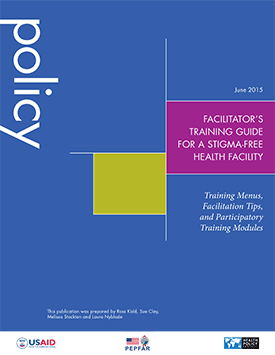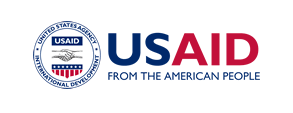The Health Policy Project ended in 2016. Work continued under Health Policy Plus (HP+) until 2022.
Stigma and Discrimination

Madison Mellish/Health Policy Project
Overview
Stigma is a powerful social process of devaluing people or groups based on a real or perceived difference—such as gender, age, sexual orientation, behavior, or ethnicity. Discrimination follows stigma and is the unfair and unjust treatment of an individual based on that socially identified status.
Stigma and discrimination are formidable barriers to effective and equitable healthcare. They keep individuals from seeking out services that can improve their health, or, in some cases, save their lives. Yet, stigma and discrimination remain seriously neglected issues, in part because of a lack of agreed upon measurement tools to quantify the extent and impacts of stigma and discrimination and gauge the effectiveness of stigma-reduction efforts.
Certain groups, such as sex workers, males who have sex with males, and people who inject drugs are highly stigmatized, restricting their access to health services. In general, women experience more stigma and discrimination than men. Stigma surrounding young people’s sexual behavior and sexuality reduces the availability of HIV and reproductive health services for youth and makes young people—who may seek to conceal their sexual activity to avoid stigma—reluctant to access services.
Evidence shows that stigma reduction is crucial to the success of HIV prevention, care, and treatment efforts. Stigma and fear of stigma discourage people from getting tested for HIV, disclosing their HIV status, seeking care, and adhering to treatment. Stigma hinders prevention efforts, as prevention methods such as condom use are often seen as indications of HIV infection, immoral behavior, or lack of trust. A recent modeling study suggests one-third to one-half of all vertical transmissions can be directly attributed to stigma. Family members and friends of people living with HIV and healthcare providers who work with people affected by HIV also experience stigma and discrimination.
While it is not yet commonly articulated, addressing stigma and discrimination could play an important role in increasing access to and uptake of family planning and reproductive health services. For example, in many places, seeking or using family planning may itself be a stigmatized behavior; discrimination restricts indigenous women’s access to maternal and reproductive health services; and stigma can affect whether women seek facility-based childbirth, thereby affecting prospects for maternal and child health. Stigma and negative perceptions surrounding birth attendants also affect prospects for safe motherhood.
What We Do
The Health Policy Project (HPP) is committed to advancing knowledge and sharing information and best practices for reducing stigma and discrimination. Our focus on stigma and discrimination reduction is part of our overall effort to expand access to health services for those in the greatest need. We
- Build the evidence base on stigma and discrimination to inform HIV prevention, care, and treatment
- Create and apply tools, methodologies, and metrics to reduce stigma and improve the quality and use of services
- Strengthen measures for scale-up of interventions for stigma reduction in healthcare settings
- Help governments develop stigma reduction frameworks and monitoring and accountability systems
- Foster partnerships among government institutions, national HIV councils, and key populations at higher risk to devise and implement policies and strategies that curb HIV-related stigma and discrimination
- Address stigma and negative perceptions surrounding birth attendants by working with parliamentary committees, health professionals, midwives, and women’s associations to advocate for increased resources for midwives and promote safe motherhood
- Increase accountability by strengthening capacity to cost stigma reduction programs and also monitor stigma reduction, thereby helping to shape policies and programs that ultimately result in health services that are free from stigma
Building the Evidence Base on Stigma and Discrimination
HPP helps build the evidence base on stigma and discrimination to support stigma reduction efforts. The project plays an active role in compiling research and literature on stigma reduction and advancing knowledge through white papers, conference participation, and website contributions. We also build global access to stigma and discrimination data and advocacy materials through a partnership with the Stigma Action Network.
Reducing HIV-Related Stigma and Discrimination in Healthcare Settings
One of the main factors hindering efforts to focus attention and resources on stigma and discrimination has been the lack of concrete measurements with which to gauge the effects of stigma and discrimination and stigma reduction efforts. HPP supports efforts to reduce stigma and discrimination into health policies and programs. Measuring stigma and developing protocols in healthcare settings are a major focus within that broader effort.
Addressing Stigma and Discrimination to Improve Maternal Health and Eliminate New Child HIV Infections
Despite improvements in the quality and availability of services to prevent vertical transmission of HIV, stigma and discrimination remain as key barriers that can discourage pregnant women living with HIV from seeking and adhering to crucial care and treatment. These services not only help prevent HIV transmission to their children—they also help pregnant women maintain their own health. However, reducing stigma is rarely a routine part of the provision of maternal health services. In response, HPP programs work to address stigma and discrimination in maternal, neonatal, and child health services to prevent mother-to-child transmission of HIV and protect the lives of women and their babies.
Publications and Resources
Comprehensive Package for Reducing Stigma and Discrimination in Health Facilities
The Health Policy Project (HPP) has led a global effort to compile and refine a coordinated package of “best practice” tools for health facilities. HPP brought together a group of international experts to review, prioritize, adapt, and synthesize existing measures and programmatic tools for stigma reduction. The tools in this package may be used or adapted to counter stigma and discrimination based on HIV status, gender identity, sexual orientation, and behaviors such as sex work or injecting drug use.
Policy Analysis and Advocacy Decision Model for HIV-Related Services: Males Who Have Sex with Males, Transgender People, and Sex Workers
The decision model is a collection of tools that helps users assess and address policy barriers that restrict access to HIV-related services for MSM/TG/SWs.
Policy Analysis and Advocacy Decision Model for Services for People Who Inject Drugs
Stigmatization of drug users by healthcare providers can affect access to HIV prevention, care and treatment services. See page 71 of this comprehensive tool.
Health Policy Project Stigma and Discrimination Activities and Accomplishments – 2012
Measuring HIV Stigma and Discrimination among Health Facility Staff -- Questionnaire
An international team of researchers developed a brief, globally standardized questionnaire for measuring stigma and discrimination in health facilities to help facilitate routine monitoring of HIV-related stigma, as well as the expansion and improvement of programming and policies at the health-facility level.
Research Shows Stigma Inhibits Uptake of PMTCT and Maternal Health Services
In their review of 150 journal articles and reports, authors Janet M. Turan (University of Alabama at Birmingham) and Laura Nyblade (Health Policy Project and RTI, International) found strong evidence that HIV stigma inhibits uptake of services along the multiple steps of the PMTCT cascade that must be followed, beginning with HIV testing during pregnancy through infant feeding.
Scaling Up Policies, Interventions, and Measurement for Stigma-Free HIV Prevention, Care, and Treatment Services
As part of an ongoing collaborative global effort to develop a standardized set of HIV-related stigma and discrimination measures for use in healthcare facilities, the Health Policy Project released a new working paper focusing on the scale-up of policies and interventions to reduce stigma in healthcare facilities.
Stigma and Discrimination: Key Barriers to Achieving Global Goals for Maternal Health and Elimination of New Child HIV Infections
This working paper examines the current evidence on stigma and discrimination and their negative impact on prevention of mother-to-child transmission (PMTCT), as well as the potential benefits of integrating PMTCT into antenatal care and maternal, neonatal, and child health services.
Stigma Action Network website
A “one-stop shop” with the latest tools, resources, research, best practices, and new initiatives in reducing HIV-related stigma and discrimination.
Designing an Effective HIV Discrimination Monitoring, Reporting, and Referral System: International Best Practices and Current Policy, Practice, and Opportunities in Ukraine
This report brings together known international best practices, research on relevant, existing legal codes and systems in Ukraine, and information from consultations with key stakeholders to determine priorities and approaches for monitoring discrimination.
Blog: Measuring HIV-related Stigma in Healthcare Settings to Reduce Discrimination Will Lead to Better Uptake of Services
Ron MacInnis, HPP’s Deputy Director for HIV Programs, examines how stigma and discrimination act as barriers to keep people from getting tested and seeking basic healthcare services.
Video: Stigma Affecting People Living with HIV or AIDS
Short video featured by HPP at the 2011 Caribbean HIV Conference that raises issues associated with stigma and discrimination.
Video: “What I Want is Simple”
A short film produced by the White Ribbon Alliance and the Health Policy Project to improve the public perception of midwives in Tanzania.


